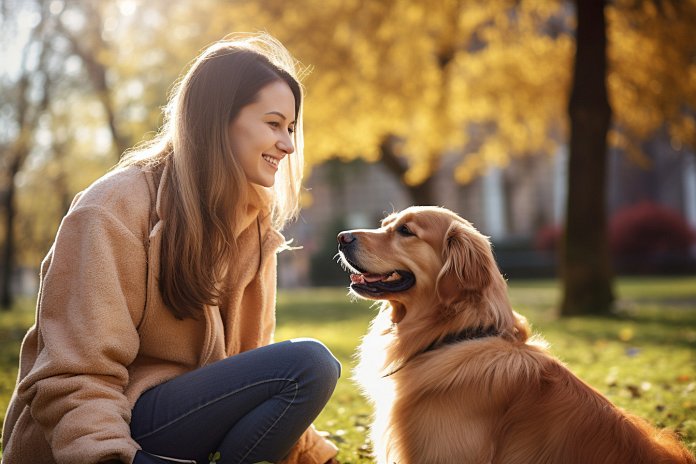
Coming home to a loving dog can bring immense comfort, especially after a long and difficult day. Dogs have the remarkable ability to understand our emotions and provide us with companionship that reflects the bond we share with them. They seem to know when we’re feeling great or when we’re sad, and can interpret our facial expressions, body language, moods, and even our health. By paying attention to our dog’s signals and context, we can learn to anticipate their needs just as they anticipate ours.
Signs Dogs Understand Human Emotion
Our dogs often seem to know us better than we know ourselves. They anticipate our routines, from waking up to coming home, and even signal when it’s time to go to bed. They display behaviors that indicate they understand our emotions, such as coming to us, nuzzling, rubbing up close, or placing their head in our lap. Dogs also exhibit calming behavior, like yawning, blinking, looking away, and keeping their tail and body low. They stay near us, waiting for signs that we’re feeling better.
Spending quality time with our dogs can provide great insight into their emotions.
They may lean on us to show love and trust, offer kisses to express affection, bring us toys to invite us to play, or raise their left eyebrow as a signal of love. These signs of love and affection are a special honor that we share with our dogs.
Body Language
Dogs often communicate their understanding of our emotions through their body language. Some of the clues they give include yawning, lip licking, low tail carriage, and blinking.
Other Signs
In addition to body language, dogs may exhibit other signs that show they understand our emotions. These include nuzzling up to us, leaning on us, giving us kisses, inviting us to play, and raising their left eyebrow.
The History of Dogs Understanding Human Emotions
Dogs have been domesticated for centuries, and their social nature and cooperative traits make them more likely to bond with humans. When humans and dogs are in close proximity, there are changes in body chemistry and the somatosensory system, which involves the sense of touch. Touch stimulates the release of oxytocin, the love hormone, and strengthens the biological connection between humans and dogs.
The Science of Dogs Telling Human Emotion
Dogs rely on their amazing senses to read our emotions. They have a keen sense of smell that allows them to detect chemical changes in our bodies triggered by emotional states. They also observe our facial expressions, body language, and the sound of our voices, which change based on emotions. Researchers have found that dogs have a cognitive understanding of human emotion and can recognize positive and negative emotional states in others.
Training Your Dog to Understand Emotion
To help your dog understand and respond to your emotions, it’s important to socialize them from a young age. Expose them to various sights, sounds, and situations, and reward them with treats for positive behavior. It’s crucial to remain calm and positive yourself, as dogs can pick up on your anxiety. Start with small steps and gradually expand their exposure, and involve your family in interacting with the pup. Ensure your dog is vaccinated before expanding their circle of experiences beyond the home.
“The comfort and companionship your dog provides is a reflection of the strong human-canine bond.”

Tips & Things to Know
1️⃣ Pay attention to your dog’s behavior and body language: Dogs have the ability to understand human emotions and can often pick up on how you’re feeling. By observing your dog’s behavior, such as nuzzling up, leaning on you, or raising their left eyebrow, you can get an idea of how your dog is feeling and what they may need from you.
2️⃣ Build a strong bond with your dog through socialization: Socializing your dog from a young age is important for their behavior and bond with humans. Expose your puppy to a variety of people, animals, sounds, and situations to help them become less fearful and more adaptable. Use positive reinforcement and rewards to encourage good behavior.
3️⃣ Be aware of your own emotions: Dogs are highly attuned to human emotions and can pick up on signals of anxiety or stress. It’s important to be a calm and positive example for your dog, especially during training and socialization. Pay attention to your own emotions and make sure you’re sending signals of calmness and positivity to your dog.
Frequently Asked Questions, Answered ✅
1. How can dogs show comfort and companionship to their owners?
– Dogs show comfort and companionship by greeting their owners, wagging their tails, and showing affection through nuzzling, rubbing up close, and placing their heads in their owners’ laps.
2. What are some signs that dogs understand human emotions?
– Dogs can interpret facial expressions, body language, moods, and even health conditions of their owners. They may exhibit calming behaviors, such as yawning, blinking, and looking away. Their tails and bodies may stay low, and they will stay near their owners, waiting for signs that they are feeling better.
3. What are some behaviors that indicate love and trust from a dog?
– Dogs may lean on their owners, give kisses (even if sloppy), bring favorite toys as an invitation to play, and lift their left eyebrow when peeking at their owners.
4. What is the connection between dogs and humans throughout history?
– Dogs have been domesticated to live with humans for centuries. Wolves, which are social animals, have traits that make them more likely to cooperate with humans. There seems to be a biological connection between humans and dogs, with changes in body chemistry and the somatosensory system when they are near each other.
5. How do dogs understand human emotions?
– Dogs use their keen senses, including their sense of smell, to detect chemical changes in the body triggered by emotional states. They can also observe facial expressions, body language, and changes in voice pitch, rhythm, and tone. Research has shown that dogs have a cognitive understanding of human emotion and can recognize positive and negative emotional states in others.